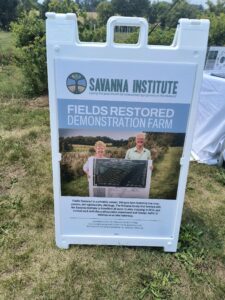Project Overview
Information Products
Commodities
Practices
- Crop Production: agroforestry, fertilizers
- Education and Training: demonstration, networking, on-farm/ranch research, participatory research, workshop
- Farm Business Management: agricultural finance, budgets/cost and returns
- Natural Resources/Environment: soil stabilization
- Pest Management: mulches - general, mulching - vegetative
- Production Systems: permaculture
- Soil Management: organic matter
- Sustainable Communities: analysis of personal/family life
Proposal summary:
Conventional annual row crops are leading to dangerous
environmental consequences and do not always lead to healthy
foods. Yearly tillage leads to wind and water erosion of
the loosened soils. The mycorrhizal fungi, bacteria, and
invertebrates that make soil healthy and vibrant get destroyed by
tillage and subsequent dehydration and oxidation.
Monocultures in the upper Midwest lead to habitat loss and
species reduction, while excess nitrogen from fertilizers is
contributing to a dead zone in the Gulf.
Agroforestry has the amazing potential to
prevent and reverse some of these consequences, but it takes 5-15
years from planting to grow a marketable product in these
perennial systems. It is arguably the most healthy farming
technique for the environment and human consumption, but if the
farmer cannot survive financially in these early years, then it
is not viable. Alley cropping with annual cash crops
between rows of trees/shrubs is another example of producing cash
flow before nut/fruit trees are productive.
Can leaves be pelletized to use as a natural soil amendment and
weed reducing mulch?
Can these pellets be used as an early revenue source for farmers
who do not yet have marketable produce?
Project objectives from proposal:
Farm Tour Poster
Approximately 15 years ago Scott made a trial batch of pelletized
leaves through the California Pellet Mill Company (CPM) in
Waterloo, IA. This was a free service at the time, but now
it has become costly to do trial studies. We have tested
this sample through A & L Great Lakes Laboratories and found that
it is a safe and inert product for soil improvement and weed
suppression. Leaves are an excellent source of carbon,
phosphorus, potassium, magnesium, and zinc. Leaves are a
renewable resource that pile up on agroforestry farms and
neighborhoods. In rural areas they blow around and slowly
degrade wherever they settle. In urban neighborhoods they
become a nuisance and are hauled away to storage/disposal
areas. We are going to collect leaves from our farms and
local municipalities in brown paper bags and recycle them into an
all natural weed suppressant, moisture retainer, and soil
booster!
A local town, Rochelle, IL allows us to bag leaves from
their collection pile, or pick up the prebagged leaves. On
our farms, this will entail mowing leaves into strips and then
raking them into piles and collecting in brown paper bags.
The bags will be stored in Scott's barn until we have a large
load that can be taken to the pellet mill via a rented U-
Haul.
The leaves can be ground and pressurized using CPM mills.
This process leads to high temperatures, approximately 150
degrees, that denature weed seeds. The finished product
consists of pellets approximately 1/2 inch in diameter x 1-2
inches in length that we can package in 20-40 pound bags.
This is a manageable size that individuals can then spread around
the bases of fruit/nut trees, berries, vegetables, and flower
beds. The leaf pellets can also be tilled into soil plots
that are too sandy, clayish, or nutrient depleted. We will
use the product on our own farms, and sell excess to local
home/garden stores, nurseries, landscapers, homeowners, and
greenhouses.
Why can't people just use leaves for mulch? Why
pelletize? Pelletizing condenses the product into a useful
density, preventing them from blowing away and deteriorating too
quickly. The pellets absorb moisture and hold it in the
soil. The heating process destroys weed seeds along with
some bacteria and fungi that can potentially infect plants.
This prevents cross-contamination to the plants that we are
applying the mulch to. We will test mixed batch, hazel,
oak, maples, hybrid poplar, etc leaves and have the samples
analyzed. We plan to take three batches of leaves to the
pellet mill using a 26-foot rented U-Haul. We are going to
test soil samples (pH, nitrogen, K, zinc, phosphorus, organic
matter) from our farms before using our pelletized leaf
product. We will test again one year later, after applying
pellets.
In some ways this is an experimental process. We know the
product can be made and we are quite confident that it will be
useful as a mulch and weed suppressant. We want to be able
to show that it improves the soil. If we can prove that
this process is beneficial, then we can promote it to our
neighbors. The economic benefit would be in sales of the
product and improved production of agricultural crops. In
the future, we might purchase a pellet mill and recycle local
leaves independently (not having to transport them and pay CPM).
